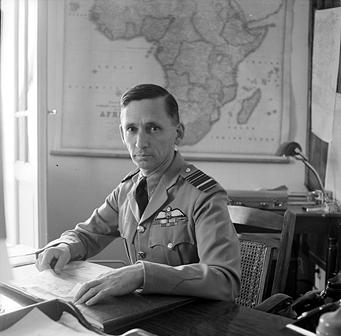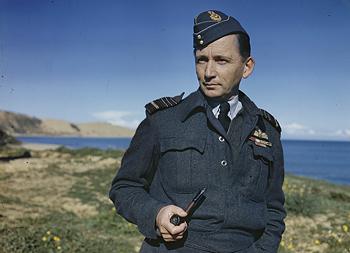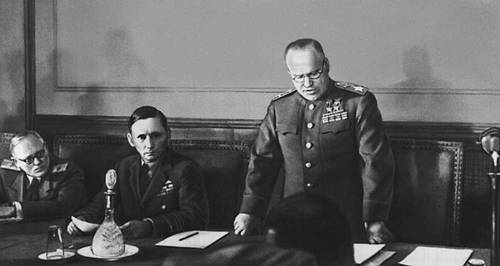<Back to Index>
- Marshal of the Royal Air Force Arthur William Tedder, 1890
PAGE SPONSOR


Marshal of the Royal Air Force Arthur William Tedder, 1st Baron Tedder, GCB (11 July 1890 – 3 June 1967) was a senior British air force commander. During the First World War, he was a pilot and squadron commander in the Royal Flying Corps and he went on to serve as a senior officer in the Royal Air Force during the inter - war years. He held high command during the Second World War, and after the war he served as Chief of the Air Staff before retiring from the RAF and taking up the position of Chancellor of the University of Cambridge.
Arthur Tedder was born in Scotland at the Glenguin Distillery (now Glengoyne) north of Glasgow in 1890. He was the son of Sir Arthur John Tedder and Emily Charlotte Bryson. His father was distinguished as the Commissioner of the Board of Customs who devised the old age pension scheme. His father's occupation meant that the young Tedder saw different parts of the British Isles, spending 1895 to 1898 in Lerwick on the Shetland Isles and 1899 – 1901 in Elgin, in the County of Moray. In 1902 the family moved to Croydon in Surrey and Tedder attended the Whitgift School until 1909 when he went up to Cambridge University. Tedder spent his university years (1909 – 13) at Magdalene College, where he read history. He was awarded a lower second - class honours in June 1912.
Tedder spent the summer of 1912 in Berlin studying German. With the start of a new academic year, he decided to return to Magdalene for a fourth year in order that he might prepare himself for a career as a diplomat. During his last year at Magdalene, Tedder gained a reserve commission as a second lieutenant in the Dorsetshire Regiment. Later in the academic year Tedder changed his mind, deciding against a diplomatic career.
After university, Tedder joined the Colonial Service as a cadet and departed England in February 1914, serving in the administration in Fiji. He did not find colonial life in Fiji to his liking and when war was declared, found a reason to return to England so that he could join the regular Army.
Tedder arrived back in England in December 1914. He was commissioned as a regular officer in the Dorsets in January 1915 and was promoted to lieutenant on 10 January. He was posted to a reserve unit at Wyke Regis on the Dorset coast where he seriously injured his knee in February. Tedder was consigned to light duties and although he was posted to Calais in July, he remained unable to carry out full infantry duties. During this time Tedder applied for a transfer to the Royal Flying Corps. In October Tedder was permitted to return to England where he continued to press for a transfer to the Flying Corps.
In January 1916, Tedder was accepted into the Royal Flying Corps and he first attended the No. 1 School of Aeronautics. In April he attended the Central Flying School where he learned to fly and gained his 'wings'. In June 1916, Tedder served as a pilot with No. 25 Squadron RFC flying the Bristol Scout C on the Western Front. Less than two months later, Tedder was given additional responsibilities as he was made a flight commander on 25 Squadron. The first day of 1917 saw Tedder promoted to major and appointed commander of No. 70 Squadron RFC. Tedder remained on the Western Front and his new squadron was equipped with the Sopwith 1½ Strutter. On 25 June 1917, he was appointed Officer Commanding No. 67 Squadron. This
new command was in Middle East and although Tedder spent under a year
as OC No. 67 Squadron, he remained in Middle East when he was made the
commander of the School of Navigation and Bomb Dropping which was based in Egypt. Another
change soon followed and on 24 June 1918 Tedder was temporarily
promoted to lieutenant colonel in the recently formed RAF and appointed
Officer Commanding 38th Wing, also based in Egypt.
After the War, Tedder accepted a permanent commission in the new Royal Air Force (RAF) as a squadron leader and commanded Nos 207 and 274 Squadrons, both based at RAF Bircham Newton. No 207 Sqn (equipped with DH9a bombers) was briefly deployed to Turkey in 1922/3 during the Chanak Crisis. No 274 Sqn was equipped with the Handley Page V/1500, the largest RAF bomber of its time. From 1923, Tedder was involved in training, both as a pupil at the RN Staff College and the Imperial Defence College and on the staff at the Directorate of Training. In 1926 as a Wing Commander, he was station commander at RAF Digby and Commandant of No. 2 Flying Training School there, later attending the RAF Staff College and the Air Armament School (as officer commanding in 1932). By 1931, Tedder had reached the rank of group captain and from 1934 to 1936 he served as Director of Training, gaining promotion to air commodore early in his tour.
In 1936, Tedder was appointed Air Officer Commanding (AOC) RAF Far Eastern Forces which gave him command over RAF units from Burma to Hong Kong and Borneo. In 1938 he became Director General for Research in the Air Ministry.
At the outbreak of war in 1939, Tedder's department was transferred to the newly created Ministry of Aircraft Production, but Tedder was unable to form a good working relationship with the minister, Lord Beaverbrook, and consequently with Prime Minister Churchill and in November 1940, he became Deputy Air Officer Commander in Chief, RAF Middle East Command.
Tedder was appointed as Air Officer Commander in Chief, RAF Middle East Command in June 1941, with the temporary rank of Air Marshal (made permanent in April 1942). He had not been Churchill's first choice for the role but when the preferred choice (Air Vice - Marshal O T Boyd) was captured, Tedder was appointed. As head of the RAF Middle East Command, he commanded Allied air operations in the Mediterranean and North Africa, covering the evacuation of Crete in May 1941 and Operation Crusader in North Africa in late 1941. In January 1942 Tedder was knighted, being appointed Knight Commander of the Order of the Bath. Tedder oversaw the build up of the air arm in the Western Desert and, more importantly, the development of new more effective operational and administrative policies which turned it into a highly effective force which was key to the Allied victory at the decisive Battle of El Alamein. One of his bombing tactics became known as the "Tedder Carpet".
In December 1943, by now a temporary Air Chief Marshal, Tedder took command of Allied Air Forces in the Mediterranean. He was involved in the planning of the Allied invasion of Sicily.
When Operation Overlord — the invasion of France — came to be planned, Tedder was appointed Deputy Supreme Commander beneath U.S. General Dwight D. Eisenhower. Finding himself with little responsibility in this new role he wrested control of the air planning for D-Day from the commander of the Allied Air Expeditionary Force, Trafford Leigh - Mallory. He developed an antipathy towards the British General Bernard Montgomery and during the difficult Battle of Normandy and later, he was a critic of Montgomery's performance and advocated Montgomery's removal from command.
In the last year of the war, Tedder was sent to Russia to seek assistance as the Western Front came under pressure during the Battle of the Bulge. When the unconditional surrender of the Germans came in May 1945 Tedder signed on behalf of General Eisenhower.
Knighted in 1942, Tedder was granted a peerage at the war's end. He followed Charles Portal as Chief of the Air Staff and served in that post from 1946 to 1950. In 1947 he delivered the Lees Knowles Lecture, which was then published as Air Power in War.
Although the nature of his war service denied him gallantry awards, Tedder received several significant foreign awards from Belgium, France, the United States and elsewhere.
Lord Tedder was the author of a historical study of the Royal Navy and also composed his war memoirs. In 1950 he became Chancellor of the University of Cambridge. In 1950 he served as the British representative on the military committee of NATO in Washington DC. He also served as Vice Chairman of the Board of Governors of the BBC. He received at least six honorary LLD degrees, and was avidly interested in astronomy. In his later years he developed Parkinson's Disease and died in Surrey in 1967, aged 76 years.
Tedder married Rosalinde Maclardy who was killed in an aircraft crash in Egypt in 1943, an event that Tedder witnessed. Tedder remarried but his second wife, Marie (Toppy) de Seton Black, predeceased him by about two years, in 1965. Tedder was the parent of: Dick (killed in France 1940), John Michael (1926 – 1994;
Late Purdie Professor of Chemistry, University of St. Andrews), and a
daughter Mina. His stepson Alasdair was also killed.
